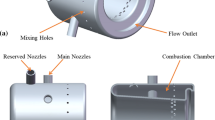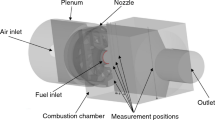Abstract
This study investigates the effects of using fuels with low heating values on the performance of an annular micro gas turbine (MGT) experimentally and numerically. The MGT used in this study is MW-54, whose original fuel is liquid (Jet A1). Its fuel supply system is re-designed to use biogas fuel with low heating value (LHV). The purpose is to reduce the size of a biogas distributed power supply system and to enhance its popularization. This study assesses the practicability of using fuels with LHVs by using various mixing ratios of methane (CH4) and carbon dioxide (CO2). Prior to experiments, the corresponding simulations, aided by the commercial code CFD-ACE+, were carried out to investigate the cooling effect in a perforated combustion chamber and combustion behavior in an annular MGT when LHV gas was used. The main purposes are to confirm that there are no hot spots occurring in the liners and the exhaust temperatures of combustor are lower than 700°C when MGT is operated under different conditions. In experiments, fuel pressure and mass flow rate, turbine rotational speed, generator power output, and temperature distribution were measured to analyze MGT performance. Experimental results indicate that the presented MGT system operates successfully under each tested condition when the minimum heating value of the simulated fuel is approximately 50% of pure methane. The power output is around 170 W at 85000 r/min as 90% CH4 with 10% CO2 is used and 70 W at 60000 r/min as 70% CH4 with 30% CO2 is used. When a critical limit of 60% CH4 is used, the power output is extremely low. Furthermore, the best theoretical Brayton cycle efficiency for such MGT is calculated as 23% according to the experimental data while LHV fuel is used. Finally, the numerical results and experiment results reveal that MGT performance can be improved further and the possible solutions for performance improvement are suggested for the future studies.
Similar content being viewed by others
References
Peirs J, Reynaerts D, Verplaetsen F. Development of an axial microturbine for a portable gas turbine generator, J Micromech Microeng, 2003, 13(4): 190–195
Peirs J, Verplaetsen F, Reynaerts D. A micro gas turbine unit for electric power generation: Design and testing of turbine and compressor. Germany: 9th International Conference on New Actuators, 2004. 796–799
Yamashita D, Kuwabara K, Tatsumi K, et al. Experimental evaluation on low-heating value fuel acceptability of micro gas turbine system operation. Prague: 16th International Symposium on Transport Phenomena, 2005. 1–7
Isomura K, Tanaka S, Togo S, et al. Development of micromachine gas turbine for portable power generation. JSME Int J Ser B Fluids Therm Eng, 2004, 47(3): 459–464
Isomura K, Tanaka S, Togo S, et al. Experimental verification of the feasibility of a 100 W class micro-scale gas turbine at an impeller diameter of 10 mm. J Micromech Microeng, 2006, 16(9): 254–261
Isomura K, Tanaka S, Togo S, et al. Development of high-speed micro-gas bearings for three-dimensional micro-turbo machines. J Micromech Microeng, 2005, 15(9): 222–227
Tanaka S, Isomura K, Togo S, et al. Turbo test rig with hydroinertia air bearings for a palmtop gas turbine. J Micromech Microeng, 2004, 14(11): 1449–1454
Wang Z H, Xi G. The effects of gas models on the predicted performance and flow of a centrifugal refrigeration compressor stage. Sci China Ser E-Tech Sci, 2008, 51(8): 1160–1168
Zhao Q J, Wang H S, Tang F, et al. Investigation of influencing factors of hot streaks migration in high pressure stage of a vaneless counter-rotating turbine. China Ser E-Tech Sci, 2008, 51(2): 127–144
ESI Group Company. CFD-ACE+ Modules Manual V1, 2004
Liou W, Leong C H. Gas turbine engine testing education at Western Michigan University. Nevada: 45th AIAA Aerospace Sciences Meeting and Exhibit, 2007. 1–9
Ennetta R, Hamdi H, Said R. Comparison of different chemical kinetic mechanisms of methane combustion in an internal combustion engine configuration. J Thermal Sci, 2008, 12(1): 43–51
Sonntag R E, Borgnakke C, Van Wylen G J. Fundamentals of Thermodynamics. New York: John Wiley & Sons, 2003. 411
Kumar S, Maruta K, Minaev S. Experimental investigations on the combustion behavior of methane-air mixtures in a micro-scale radial combustor configuration, J Micromech Microeng, 2007, 17(5): 900–908
Author information
Authors and Affiliations
Corresponding author
Additional information
Supported by the ‘National’ Science Council of Taiwan, China (Grant No. NSC 96-2218-E-009-002) and Ted Knoy is appreciated for his editorial assistance
Rights and permissions
About this article
Cite this article
Yang, C., Lee, C., Hsiao, J. et al. Numerical analyses and experiment investigations of an annular micro gas turbine power system using fuels with low heating values. Sci. China Ser. E-Technol. Sci. 52, 3565–3579 (2009). https://doi.org/10.1007/s11431-009-0312-0
Received:
Accepted:
Published:
Issue Date:
DOI: https://doi.org/10.1007/s11431-009-0312-0




